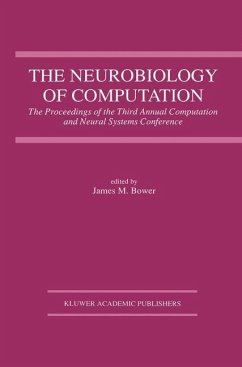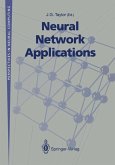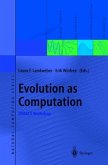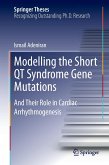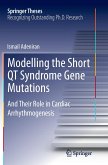The Neurobiology of Computation
Proceedings of the Third Annual Computation and Neural Systems Conference
Herausgegeben:Bower, James M.
The Neurobiology of Computation
Proceedings of the Third Annual Computation and Neural Systems Conference
Herausgegeben:Bower, James M.
- Broschiertes Buch
- Merkliste
- Auf die Merkliste
- Bewerten Bewerten
- Teilen
- Produkt teilen
- Produkterinnerung
- Produkterinnerung
This volume includes papers presented at the Third Annual Computation and Neural Systems meeting (CNS_94) held in Monterey California, July 21 - July 26, 1994. This collection includes 71 of the more than 100 papers presented at this year's meeting. Acceptance for meeting presentation was based on the peer review of preliminary papers by at least two referees. The papers in this volume were submitted in final form after the meeting. As represented by this volume, CNS meetings continue to expand in quality, size and breadth of focus as increasing numbers of neuroscientists are taking a…mehr
Andere Kunden interessierten sich auch für
![Robots and Biological Systems: Towards a New Bionics? Robots and Biological Systems: Towards a New Bionics?]() DarioRobots and Biological Systems: Towards a New Bionics?229,99 €
DarioRobots and Biological Systems: Towards a New Bionics?229,99 €![Neural Network Applications Neural Network Applications]() Neural Network Applications39,99 €
Neural Network Applications39,99 €![Evolution as Computation Evolution as Computation]() Evolution as Computation77,99 €
Evolution as Computation77,99 €![Adaptability Adaptability]() Adaptability77,99 €
Adaptability77,99 €![Modelling the Short QT Syndrome Gene Mutations Modelling the Short QT Syndrome Gene Mutations]() Ismail AdeniranModelling the Short QT Syndrome Gene Mutations75,99 €
Ismail AdeniranModelling the Short QT Syndrome Gene Mutations75,99 €![Modelling the Short QT Syndrome Gene Mutations Modelling the Short QT Syndrome Gene Mutations]() Ismail AdeniranModelling the Short QT Syndrome Gene Mutations75,99 €
Ismail AdeniranModelling the Short QT Syndrome Gene Mutations75,99 €![How Can Physics Underlie the Mind? How Can Physics Underlie the Mind?]() George EllisHow Can Physics Underlie the Mind?67,99 €
George EllisHow Can Physics Underlie the Mind?67,99 €-
-
-
This volume includes papers presented at the Third Annual Computation and Neural Systems meeting (CNS_94) held in Monterey California, July 21 - July 26, 1994. This collection includes 71 of the more than 100 papers presented at this year's meeting. Acceptance for meeting presentation was based on the peer review of preliminary papers by at least two referees. The papers in this volume were submitted in final form after the meeting. As represented by this volume, CNS meetings continue to expand in quality, size and breadth of focus as increasing numbers of neuroscientists are taking a computational approach to understanding nervous system function. The CNS meetings are intended to showcase the best of current research in computational neuroscience. As such the meeting is fundamentally focused on understanding the relationship between the structure of neIVOUS systems and their function. What is clear from the continued expansion of the CNS meetings is that computational approachesare increasingly being applied at all levels of neurobiological analysis. in an ever growing number of experimental preparations. and neural subsystems. Thus. experimental subjects range from crickets to primates; sensory systems range from vision to electroreception; experimental approaches range from realistic models of ion channels to the analysis of the information content of spike trains. For this reason, the eNS meetings represent an opportunity for computational neurobiologists to consider their research results in a much broader context than is usually possible.
Hinweis: Dieser Artikel kann nur an eine deutsche Lieferadresse ausgeliefert werden.
Hinweis: Dieser Artikel kann nur an eine deutsche Lieferadresse ausgeliefert werden.
Produktdetails
- Produktdetails
- Verlag: Springer / Springer US / Springer, Berlin
- Artikelnr. des Verlages: 978-1-4613-5940-1
- Softcover reprint of the original 1st ed. 1995
- Seitenzahl: 464
- Erscheinungstermin: 12. November 2012
- Englisch
- Abmessung: 235mm x 155mm x 25mm
- Gewicht: 698g
- ISBN-13: 9781461359401
- ISBN-10: 1461359406
- Artikelnr.: 39501233
- Herstellerkennzeichnung
- Springer-Verlag GmbH
- Tiergartenstr. 17
- 69121 Heidelberg
- ProductSafety@springernature.com
- Verlag: Springer / Springer US / Springer, Berlin
- Artikelnr. des Verlages: 978-1-4613-5940-1
- Softcover reprint of the original 1st ed. 1995
- Seitenzahl: 464
- Erscheinungstermin: 12. November 2012
- Englisch
- Abmessung: 235mm x 155mm x 25mm
- Gewicht: 698g
- ISBN-13: 9781461359401
- ISBN-10: 1461359406
- Artikelnr.: 39501233
- Herstellerkennzeichnung
- Springer-Verlag GmbH
- Tiergartenstr. 17
- 69121 Heidelberg
- ProductSafety@springernature.com
Section 1: Subcellular.- 1 A Mathematical Description of Quantal Analysis with Applications.- 2 Fast Kinetic Models for Simulating AMPA, NMDA, GABAAand GABAB Receptors.- 3 An Equilibrium Model of Biochemical Interactions Between Glutamatergic and Dopaminergic Signals in Striatal Neurons.- 4 Simulation of the Molecular Mechanisms Regulating Neurotransmitter Release.- 5 The Potassium A-Current Low Firing Rates in Hodgkin-Huxley Models.- 6 Apparent Diffusion Coefficient Estimation Errors from Using Ratio of Bound to Unbound Ca2+.- Section 2: Cellular.- 7 Information Maintenance by Retinal Ganglion Cell Spikes.- 8 Modeling the Bursting Interneurons of the Lobster Cardiac Ganglion.- 9 Precision and Reliability of Neocortical Spike Trains in the Behaving Monkey.- 10 Summation and Division in V1 Simple Cells.- 11 Qualitative Electrotonic Comparison of Three Classes of Hippocampal Neurons in the Rat.- 12 A New Spike Train Analysis Technique for Detecting Trends in the Firing Patterns of Neurons.- 13 A Mathematical Model of Retinal Photoreceptors.- 14 Short-Term Memory as a Single Cell Phenomenon.- 15 The Importance of Membrane Properties and Synaptic Location in Octopus Cells of the Mammalian Cochlear Nucleus: A Modeling Study.- 16 Hypertext Software For Modeling Neurons.- 17 The STEM Cell: A Computational Model of Biological Neurons Useful for Spatio-Temporal Pattern Recognition.- 18 Functional Interactions Between Inwardly Rectifying Conductances and GABAA-mediated Inhibition.- 19 A Compartmental Model of the Cochlear Nucleus Stellate Cell: Responses to Constant And Amplitude-Modulated Tones.- 20 Is A Classification of Honeybee Antennal Lobe Neurones Grown in Culture Possible? - Yes!.- 21 How Does Retinal Preprocessing Affect the Receptive Field of A Stabilized Hebbian Neuron.- 22 Electrotonic Structure and Synaptic Variability in Cortical Neurons.- 23 Synaptic Coding of Time-Varing Spike Trains.- 24 Calculation of Passive Membrane Properties for Experimentally Determined Dendritic Geometries of Laterodorsal Tegmental Neurons in Vitro.- 25 Dendritic Electrotonic Extent and Branching Pattern Topology.- Section 3: Network.- 26 Localised Neuronal Assemblies with Recurrent Synapses Enable Global Temporal Synchronisation.- 27 Attention As Selective Synchronization of Oscillating Cortical Sensory and Motor Associative Memories.- 28 Perceptual Topography: Spatio-Temporal Analysis of Prepyriform, Visual, Auditory, and Somesthetic EEGs in Perception by Trained Rabbits.- 29 BIONNIC: An Efficient and Flexible Integrator for Biological Neural Network Simulators.- 30 A Retina Model Including Dopaminergic Neuromodulation.- 31 Parameter Optimization of Olfactory Neurodynamics.- 32 Model Synapses with Frequency Potentiation Characteristics Can Cooperatively Enhance Hebbian Learning.- 33 Low Spiking Rates in a Network With Overlapping Assemblies.- 34 The Role of Feedback in Respiratory Amplitude and Frequency Modulation.- 35 Partial and Full Synchrony of Thalamic Spindle Oscillations.- 36 On The Stochastic Stability of a Neural Network Model of Somatosensory Information Processing.- 37 Feedback Regulation of Cholinergic Modulation and Hippocampal Memory Function.- 38 Analyzing the Hippocampal Place Cell Phenomenon by Modeling the Central Visual Pathway.- 39 Effects of Asymmetric Neuronal Connectivity and Dopamine on Striatal Function: Simulation and Analysis of a Model for Huntington's Disease.- 40 Learning and Classification in a Noisy Environment by A Simulated Cortical Network.- 41 Improving the Realism of Attractor Models by Using Cortical Columns asFunctional Units.- 42 Oscillations, Chaos and Noise in Associative Memory.- 43 Ordor Processing in the Honey Bee's Antennal Lobe Glomeruli: Modeling Sensory Memory.- 44 The Interplay of Intrinsic and Synaptic Currents in a Half-Center Oscillator.- 45 A Model of the Spatial-Frequency Organization in Primate Striate Cortex.- 46 A 3-D Interactive Model for Peripheral Vestibular Signal Processing.- 47 Models of Adaptive Electrosensory Self-Noise Cancellation in a Cerebellar-Like Structure in the Elasmobranch Hindbrain.- 48 Multistable Phase-Clustering in Networks of Spiking Neurons.- 49 Decoding Vectorial Information from Firing Rates.- 50 Modeling Cortical Plasticity Based on Adapting Lateral Interaction.- 51 An Emergent Model of Visual Cortical Orientation Selectivity.- 52 Computational and Neurobiological Features of a Network of Networks.- 53 Using Fictive Powers as Event Markers in EEG Data Processing.- 54 Visual Segmentation and Feature Binding Without Synchronization.- 55 Oscillatory Field Potentials in the Presence of Irregular Single Cell Discharge Patterns.- 56 Stimulus-Dependent Synchronization in a Model of Orientation-Tuned Spiking Neurons.- 57 XNBC: A Simulation Tool for Neurobiologists.- 58 Simulations of the Intersegmental Coordination During Swimming in the Lamprey Using A Continuous Network Model.- 59 Linear and Nonlinear Dynamics in the Development of Orientation Preference Maps.- Section 4: Systems.- 60 Neural System of Fear Conditioning: A connectionist Model.- 61 The Generation of Expectations In Cerebellum-Like Structures.- 62 A Neural Controller for Single-Leg Substrate-Finding: A First Step Toward Agile Locomotion in Insects and Robots.- 63 VLSI Neuromorphs: Building Blocks for Neural Circuits.- 64 Test of a Two-Layer Network as a Model of HumanEntry-Level Object Recognition.- 65 Understanding Ocular Dominance Development from Binocular Input Statistics.- 66 Timing a Looming Object.- 67 Depth from Transparency.- 68 Cortical Competitive Processing Produces Interference In Color-Word Tests.- 69 A Computational Model of Attentional Focus: The Searchlight of Attention Hypothesis Revisited.- 70 Neural Implementation of Bayesian Vision Theories by Unsupervised Learning.- 71 Comparison of Gender Recognition by PDP asnd Radial Basis Function Networks.
Section 1: Subcellular.- 1 A Mathematical Description of Quantal Analysis with Applications.- 2 Fast Kinetic Models for Simulating AMPA, NMDA, GABAAand GABAB Receptors.- 3 An Equilibrium Model of Biochemical Interactions Between Glutamatergic and Dopaminergic Signals in Striatal Neurons.- 4 Simulation of the Molecular Mechanisms Regulating Neurotransmitter Release.- 5 The Potassium A-Current Low Firing Rates in Hodgkin-Huxley Models.- 6 Apparent Diffusion Coefficient Estimation Errors from Using Ratio of Bound to Unbound Ca2+.- Section 2: Cellular.- 7 Information Maintenance by Retinal Ganglion Cell Spikes.- 8 Modeling the Bursting Interneurons of the Lobster Cardiac Ganglion.- 9 Precision and Reliability of Neocortical Spike Trains in the Behaving Monkey.- 10 Summation and Division in V1 Simple Cells.- 11 Qualitative Electrotonic Comparison of Three Classes of Hippocampal Neurons in the Rat.- 12 A New Spike Train Analysis Technique for Detecting Trends in the Firing Patterns of Neurons.- 13 A Mathematical Model of Retinal Photoreceptors.- 14 Short-Term Memory as a Single Cell Phenomenon.- 15 The Importance of Membrane Properties and Synaptic Location in Octopus Cells of the Mammalian Cochlear Nucleus: A Modeling Study.- 16 Hypertext Software For Modeling Neurons.- 17 The STEM Cell: A Computational Model of Biological Neurons Useful for Spatio-Temporal Pattern Recognition.- 18 Functional Interactions Between Inwardly Rectifying Conductances and GABAA-mediated Inhibition.- 19 A Compartmental Model of the Cochlear Nucleus Stellate Cell: Responses to Constant And Amplitude-Modulated Tones.- 20 Is A Classification of Honeybee Antennal Lobe Neurones Grown in Culture Possible? - Yes!.- 21 How Does Retinal Preprocessing Affect the Receptive Field of A Stabilized Hebbian Neuron.- 22 Electrotonic Structure and Synaptic Variability in Cortical Neurons.- 23 Synaptic Coding of Time-Varing Spike Trains.- 24 Calculation of Passive Membrane Properties for Experimentally Determined Dendritic Geometries of Laterodorsal Tegmental Neurons in Vitro.- 25 Dendritic Electrotonic Extent and Branching Pattern Topology.- Section 3: Network.- 26 Localised Neuronal Assemblies with Recurrent Synapses Enable Global Temporal Synchronisation.- 27 Attention As Selective Synchronization of Oscillating Cortical Sensory and Motor Associative Memories.- 28 Perceptual Topography: Spatio-Temporal Analysis of Prepyriform, Visual, Auditory, and Somesthetic EEGs in Perception by Trained Rabbits.- 29 BIONNIC: An Efficient and Flexible Integrator for Biological Neural Network Simulators.- 30 A Retina Model Including Dopaminergic Neuromodulation.- 31 Parameter Optimization of Olfactory Neurodynamics.- 32 Model Synapses with Frequency Potentiation Characteristics Can Cooperatively Enhance Hebbian Learning.- 33 Low Spiking Rates in a Network With Overlapping Assemblies.- 34 The Role of Feedback in Respiratory Amplitude and Frequency Modulation.- 35 Partial and Full Synchrony of Thalamic Spindle Oscillations.- 36 On The Stochastic Stability of a Neural Network Model of Somatosensory Information Processing.- 37 Feedback Regulation of Cholinergic Modulation and Hippocampal Memory Function.- 38 Analyzing the Hippocampal Place Cell Phenomenon by Modeling the Central Visual Pathway.- 39 Effects of Asymmetric Neuronal Connectivity and Dopamine on Striatal Function: Simulation and Analysis of a Model for Huntington's Disease.- 40 Learning and Classification in a Noisy Environment by A Simulated Cortical Network.- 41 Improving the Realism of Attractor Models by Using Cortical Columns asFunctional Units.- 42 Oscillations, Chaos and Noise in Associative Memory.- 43 Ordor Processing in the Honey Bee's Antennal Lobe Glomeruli: Modeling Sensory Memory.- 44 The Interplay of Intrinsic and Synaptic Currents in a Half-Center Oscillator.- 45 A Model of the Spatial-Frequency Organization in Primate Striate Cortex.- 46 A 3-D Interactive Model for Peripheral Vestibular Signal Processing.- 47 Models of Adaptive Electrosensory Self-Noise Cancellation in a Cerebellar-Like Structure in the Elasmobranch Hindbrain.- 48 Multistable Phase-Clustering in Networks of Spiking Neurons.- 49 Decoding Vectorial Information from Firing Rates.- 50 Modeling Cortical Plasticity Based on Adapting Lateral Interaction.- 51 An Emergent Model of Visual Cortical Orientation Selectivity.- 52 Computational and Neurobiological Features of a Network of Networks.- 53 Using Fictive Powers as Event Markers in EEG Data Processing.- 54 Visual Segmentation and Feature Binding Without Synchronization.- 55 Oscillatory Field Potentials in the Presence of Irregular Single Cell Discharge Patterns.- 56 Stimulus-Dependent Synchronization in a Model of Orientation-Tuned Spiking Neurons.- 57 XNBC: A Simulation Tool for Neurobiologists.- 58 Simulations of the Intersegmental Coordination During Swimming in the Lamprey Using A Continuous Network Model.- 59 Linear and Nonlinear Dynamics in the Development of Orientation Preference Maps.- Section 4: Systems.- 60 Neural System of Fear Conditioning: A connectionist Model.- 61 The Generation of Expectations In Cerebellum-Like Structures.- 62 A Neural Controller for Single-Leg Substrate-Finding: A First Step Toward Agile Locomotion in Insects and Robots.- 63 VLSI Neuromorphs: Building Blocks for Neural Circuits.- 64 Test of a Two-Layer Network as a Model of HumanEntry-Level Object Recognition.- 65 Understanding Ocular Dominance Development from Binocular Input Statistics.- 66 Timing a Looming Object.- 67 Depth from Transparency.- 68 Cortical Competitive Processing Produces Interference In Color-Word Tests.- 69 A Computational Model of Attentional Focus: The Searchlight of Attention Hypothesis Revisited.- 70 Neural Implementation of Bayesian Vision Theories by Unsupervised Learning.- 71 Comparison of Gender Recognition by PDP asnd Radial Basis Function Networks.

